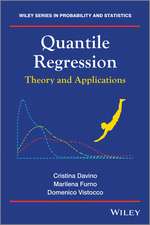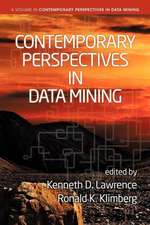Composite Sampling: A Novel Method to Accomplish Observational Economy in Environmental Studies: Environmental and Ecological Statistics, cartea 4
Autor Ganapati P. Patil, Sharad D. Gore, Charles Taillieen Limba Engleză Paperback – 25 ian 2013
| Toate formatele și edițiile | Preț | Express |
|---|---|---|
| Paperback (1) | 640.24 lei 6-8 săpt. | |
| Springer Us – 25 ian 2013 | 640.24 lei 6-8 săpt. | |
| Hardback (1) | 646.43 lei 6-8 săpt. | |
| Springer Us – 28 dec 2010 | 646.43 lei 6-8 săpt. |
Preț: 640.24 lei
Preț vechi: 753.22 lei
-15% Nou
Puncte Express: 960
Preț estimativ în valută:
122.51€ • 131.01$ • 102.15£
122.51€ • 131.01$ • 102.15£
Carte tipărită la comandă
Livrare economică 18 aprilie-02 mai
Preluare comenzi: 021 569.72.76
Specificații
ISBN-13: 9781461427896
ISBN-10: 1461427894
Pagini: 292
Ilustrații: XIII, 275 p.
Dimensiuni: 155 x 235 x 15 mm
Greutate: 0.41 kg
Ediția:2011
Editura: Springer Us
Colecția Springer
Seria Environmental and Ecological Statistics
Locul publicării:New York, NY, United States
ISBN-10: 1461427894
Pagini: 292
Ilustrații: XIII, 275 p.
Dimensiuni: 155 x 235 x 15 mm
Greutate: 0.41 kg
Ediția:2011
Editura: Springer Us
Colecția Springer
Seria Environmental and Ecological Statistics
Locul publicării:New York, NY, United States
Public țintă
ResearchCuprins
Introduction.- Classification.- Extreme Values.- Estimating Prevalence.- Bayesian Approach.- Inference on Mean and Variance.- Random Weights.- A Linear Model.- Site Characterization and Cleanup.- Spatial Structures.- Sampling of Soils and Sediments.- Sampling of Liquids and Fluids.- Indoor Air Pollution.- Bioaccumulation.- References.
Recenzii
From the reviews:
“In this monograph, the authors present the work of a 4-year initiative undertaken in the United States and discuss several previously unpublished results and applications of composite sampling in environmental studies. … the theory presented is sufficient to understand the formal analytical approaches and the solutions presented. The text … is well worth reading. … will appeal to those practitioners needing to balance the desire for statistical rigour in sampling design with the constraints of ever decreasing financial budgets with which to undertake such sampling.” (Carl M. O’Brien, International Statistical Review, Vol. 80 (1), 2012)
“The book by Patil, Gore, and Taillie provides a detailed yet accessible overview of composite sampling and elaborates on the issues and tradeoffs that arise in the context of various practical applications. … will appeal to the student or the general scientific reader looking for a comprehensive overview … . The authors of this book have provided an excellent entry and addition to the literature on composite sampling.” (Ramesh Natarajan, Technometrics, Vol. 54 (1), February, 2012)
“In this monograph, the authors present the work of a 4-year initiative undertaken in the United States and discuss several previously unpublished results and applications of composite sampling in environmental studies. … the theory presented is sufficient to understand the formal analytical approaches and the solutions presented. The text … is well worth reading. … will appeal to those practitioners needing to balance the desire for statistical rigour in sampling design with the constraints of ever decreasing financial budgets with which to undertake such sampling.” (Carl M. O’Brien, International Statistical Review, Vol. 80 (1), 2012)
“The book by Patil, Gore, and Taillie provides a detailed yet accessible overview of composite sampling and elaborates on the issues and tradeoffs that arise in the context of various practical applications. … will appeal to the student or the general scientific reader looking for a comprehensive overview … . The authors of this book have provided an excellent entry and addition to the literature on composite sampling.” (Ramesh Natarajan, Technometrics, Vol. 54 (1), February, 2012)
Textul de pe ultima copertă
This monograph provides, for the first time, a most comprehensive statistical account of composite sampling as an ingenious environmental sampling method to help accomplish observational economy in a variety of environmental and ecological studies. Sampling consists of selection, acquisition, and quantification of a part of the population. But often what is desirable is not affordable, and what is affordable is not adequate. How do we deal with this dilemma? Operationally, composite sampling recognizes the distinction between selection, acquisition, and quantification. In certain applications, it is a common experience that the costs of selection and acquisition are not very high, but the cost of quantification, or measurement, is substantially high. In such situations, one may select a sample sufficiently large to satisfy the requirement of representativeness and precision and then, by combining several sampling units into composites, reduce the cost of measurement to an affordable level. Thus composite sampling offers an approach to deal with the classical dilemma of desirable versus affordable sample sizes, when conventional statistical methods fail to resolve the problem. Composite sampling, at least under idealized conditions, incurs no loss of information for estimating the population means. But an important limitation to the method has been the loss of information on individual sample values, such as the extremely large value. In many of the situations where individual sample values are of interest or concern, composite sampling methods can be suitably modified to retrieve the information on individual sample values that may be lost due to compositing. In this monograph, we present statistical solutions to these and other issues that arise in the context of applications of composite sampling.
Caracteristici
Presents statistical solutions to issues that arise in the context of applications of composite sampling Gives emphasis to the most recent results that are not covered in review papers and other monographs Examines cost analysis of composite sampling, and why it is so difficult to determine expected measurements Includes supplementary material: sn.pub/extras

















